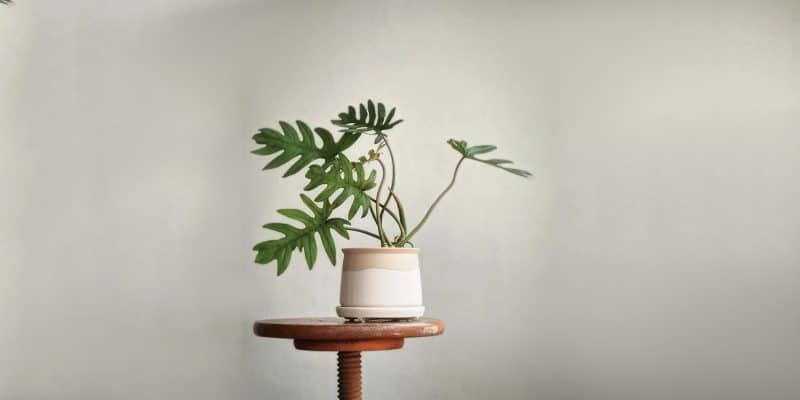The Philodendron Mayoi is kind of like having a miniature palm tree in your living room, just a bit less big.
It’s got smaller leaves than some of its relatives, plus a quirky growth habit that forms some pretty interesting leaf shapes.
We’ll cover Philodendron Mayoi care, its unique features, and how to propagate more for your friends. We’ll also get into the issues we see the most and what to do about them.
Let’s get growing!
Table of Contents
Philodendron Mayoi Plant Care Guide
History, Habitat, and Characteristics
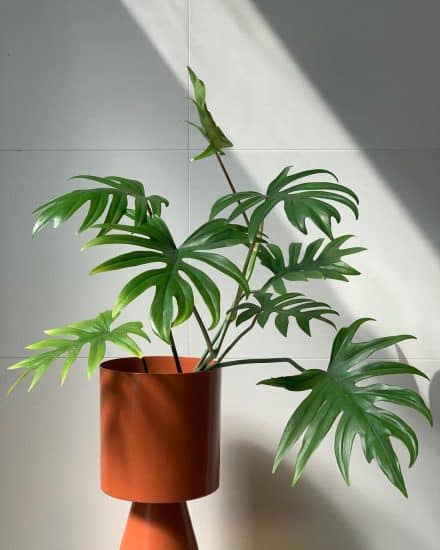
Philodendron Mayoi hails from Brazil and is a proud member of the Araceae family. Named in honor of the renowned botanist Dr. Simon Mayo from Kew Gardens in London, Philodendron Mayoi flaunts palmate leaves and a fast, vining growth pattern.
This intriguing scrambler-type (a climber that needs support) plant sports hand-sized leaves, making it more compact than some of its larger Philodendron cousins.
The real twist is its growth pattern. Philodendron Mayoi often presses pause on developing leaves on specific stems, focusing instead on new growth towards the tips and edges, creating an intricate and unique shape.
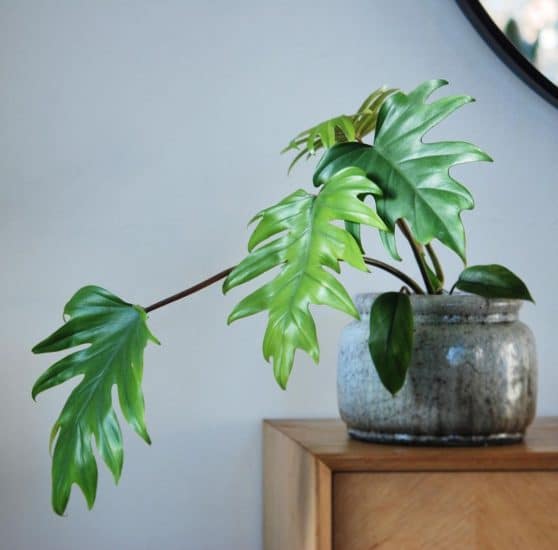
Although the Philodendron Mayoi is distinctive, with its dark green underside veins, it’s worth noting that it’s sometimes sold under the pseudonym Philodendron tahiti. However, experts believe this to be just another name for Philodendron mayoi, rather than a separate cultivar.
What sets the Philodendron Mayoi apart from other plants in its family are its compact size and unconventional growth pattern. While it shares some care requirements with its relatives, such as needing well-draining soil and moderate light, Philodendron mayoi’s long stems and wide leaves add an extra layer of charm.
Light
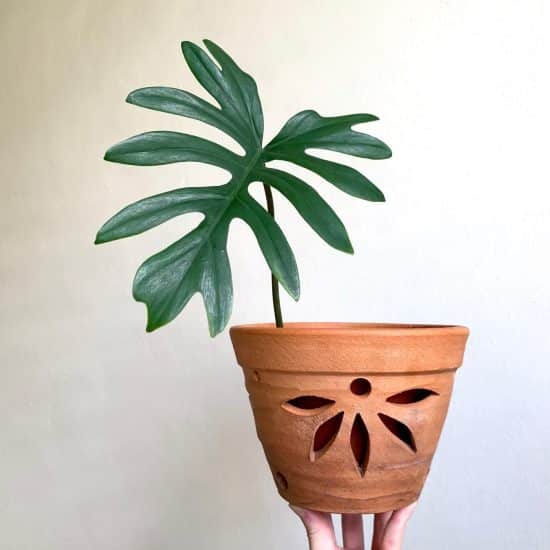
As a competitive indoor dweller, Philodendron Mayoi can adapt to various lighting conditions, but it will do best with bright, indirect sunlight.
These adaptable tropical plants can grow quite well under artificial lights or near an east- or northwest-facing window. If you think your window might provide too much direct light, use a sheer curtain to filter the light but still give your plant bright conditions.
A completely north-facing window may not provide sufficient bright light, but since this is an adaptable plant, give it a try if it’s all you have. But be careful with south-facing windows — too much direct sun might scorch your plant’s lovely leaves. Set it off to the side a bit if you must place it in a south window.
If this member of the Philodendron species isn’t getting the right light, it’ll definitely let you know. Insufficient light can result in a struggling Philodendron mayoi that stretches towards the light and sports smaller leaves. In contrast, excessive light can cause brown leaves, scorched or yellowing foliage, and stunted growth.
Our lighting tips:
- Give Philodendron Mayoi bright, indirect light for best results.
- In south- or west-facing windows, place the plant a few feet away to avoid sunburn, or use a sheer curtain.
- Don’t shy away from using artificial lights to provide the ideal lighting conditions for your tropical plant.
- Rotate your plant regularly, ensuring even light exposure to avoid a lopsided, leaning philodendron.
Water
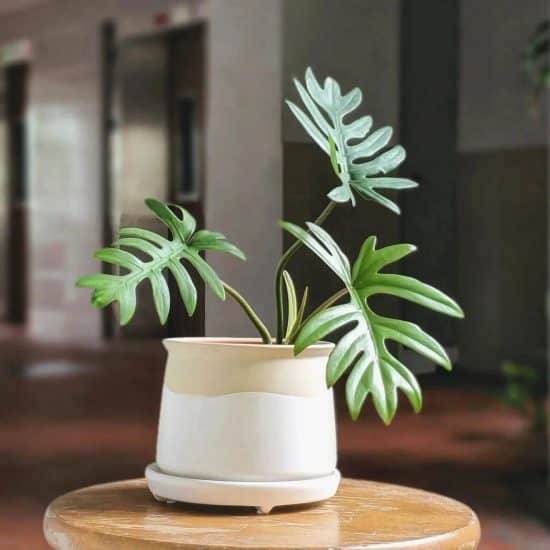
Philodendron Mayoi is quite forgiving when it comes to watering, making it an ideal houseplant for busy or forgetful plant parents. The worst thing you can do to this philodendron is overwater it, so let the top half of the soil dry out before watering.
Overwatering your Philodendron Mayoi can lead to yellowing leaves and mushy stems, and may even lead to root rot. You might also notice that the soil stays wet longer than it should, never quite drying out. To remedy this, cut back on your watering schedule and let the soil dry out before giving your plant another drink.
When your Philodendron Mayoi isn’t getting enough water, its leaves will wilt and droop. Fortunately, this resilient plant typically bounces back once you provide it with some much-needed hydration.
Our tips:
- Water your Philodendron Mayoi when the top few inches of soil are dry.
- During the active growing season, like spring and summer, your plant will require more water, while in winter, it will require less due to slower growth.
Temperature and Humidity
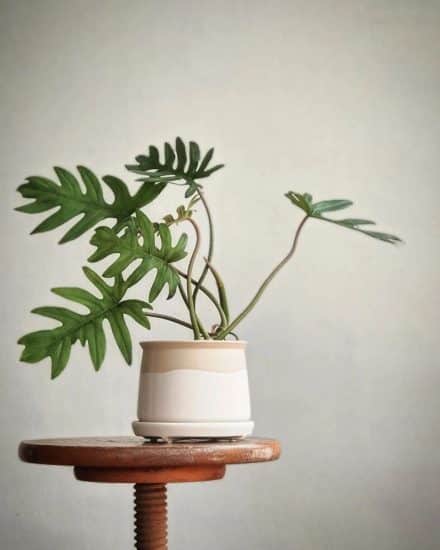
The Philodendron Mayoi plant comes from a warm, humid environment, so finding the right balance between temperature and humidity is crucial. Let’s explore the best conditions for your plant’s well-being.
Temperature plays a vital role in your Philodendron Mayoi’s happiness, with the ideal temperature range being 65-80°F (18-27°C). Keep an eye out for cold drafts from windows or doors, and avoid sudden temperature changes, which can stress the plant and harm the leaves.
Luckily, humidity is more flexible for this adaptable plant. Though it thrives in medium to high humidity, it can adjust to lower levels as well. Aim for a humidity range of 40%-60%. Dry, brown leaf tips can signal low humidity, while yellowing leaves or mold growth might indicate excessive moisture.
If you spot brown, crispy leaves, it’s time to increase humidity. You can do this by running a humidifier near your plant a few hours each day, or placing your plant on a drip tray filled with pebbles and a bit of water — but not enough to keep the roots sitting in water.
Soil and Planting
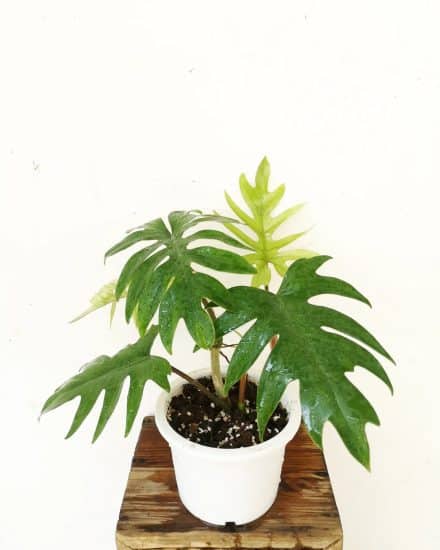
To create a good soil mix for your Philodendron Mayoi, use a 50-50 or 40-60 ratio of soil and sand. This helps keep the soil less compact and more hospitable to the plant’s root system.
Start with a high-quality, well-draining potting mix as the base for your Philodendron Mayoi soil. Incorporate sand into the potting mix to improve drainage and prevent soil compaction, crucial for the plant’s root health and overall growth. Adding one part orchid bark can also help create a well-drained potting medium.
During the growing season, fertilizing your Philodendron Mayoi is essential. Use a well-balanced, water-soluble fertilizer every 2 to 4 weeks in spring and summer. Be mindful of the signs of too much fertilizer, including leaf tip burn, yellowing or browning of the plant’s leaves, and stunted growth.
To fix over-fertilization, flush the soil with water to remove excess salts and reduce the fertilizer application frequency, helping avoid further root burn.
Repotting your Philodendron Mayoi might not be a frequent requirement, but it’s still a good practice to do so when the plant outgrows its current nursery pot, usually every 2 to 3 years. Keep an eye out for signs like roots growing out of the drainage holes, slow growth, or soil that dries out too quickly.
Propagation
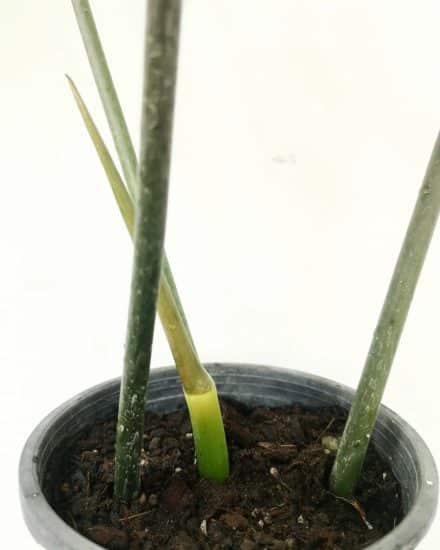
Propagating Philodendron Mayoi, a tropical plant, is an easy way to multiply your plant and can be achieved through stem cutting.
Propagating Philodendron Mayoi via stem cuttings:
- Grab your clean tools, like sterilized gardening shears or scissors, to ensure your healthy plants stay free from infection.
- Find a good-looking stem with at least one dark green leaf and one node, then make a cut just behind the node to encourage new growth.
- Choose your rooting medium: soil or water. For soil propagation, plant the stem cutting directly into a small pot with well-drained potting soil, and keep it moist but not soggy. For water propagation, pop the cutting into a container of fresh water, making sure the cut end is submerged, and change the water every few days.
- Keep an eye on the progress of your little Philodendron Mayoi. When you see roots forming and growing about an inch or two, it’s time to plant your stem cuttings into a proper pot.
Propagating Philodendron Mayoi via air layering:
- Pick out a healthy stem with a node and have some wet sphagnum moss ready to go.
- Wrap the node with the wet coconut coir, making sure it’s damp and well-covered to absorb moisture.
- Cover up the coco coir using plastic wrap and secure it with twine. This keeps the humidity just right for the aerial roots to grow.
- Watch for roots developing within the moss — that’s your sign that it’s working!
- When you see roots, cut the stem below the air-layered section and carefully remove the plastic wrap.
- Plant your new cutting in a small pot with well-drained potting soil, and keep the soil consistently moist for the first few weeks to help it along.
Common Issues
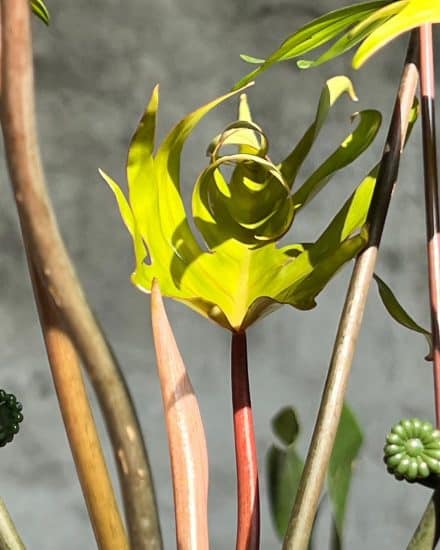
While Philodendron Mayoi is generally low maintenance, occasionally the plant might encounter some issues.
Slow Growth
If you notice your Philodendron Mayoi is growing slowly, it could be due to a lack of light or insufficient nutrients. When the plant develops new leaves mainly at the tips and edges, it’s likely craving more light. In this case, try moving your plant to a spot with bright, but indirect, light.
If the slow growth persists, consider providing your plant with a balanced, water-soluble fertilizer every 4 to 6 weeks during the growing season. This extra boost of nutrients can make a big difference in your philodendron’s growth rate!
Leaf Burn
Nobody wants to see their beloved Philodendron Mayoi suffer from leaf burn, which can be identified by yellow or brown patches on the leaves. This issue is typically caused by excessive exposure to direct sunlight.
To help your plant recover, find a new location that provides bright, indirect light. Another option is to use a grow light specifically designed for houseplants. Keep an eye on your Philodendron Mayoi’s progress, and remember that it might take some time for it to bounce back and produce new, healthy leaves.
Pests and Diseases
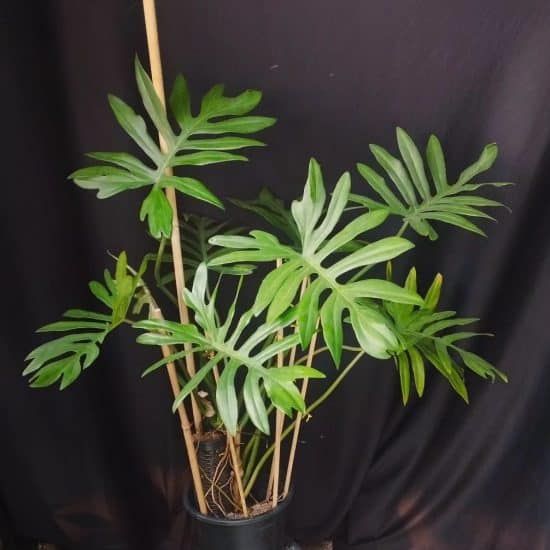
Philodendron Mayoi is usually a happy and healthy indoor houseplant, but it might occasionally face a few issues with pests or diseases.
Pests
This indoor beauty is quite resistant to pests, but sometimes thrips might decide to invade your plant’s leaves. These tiny insects can cause damage by feeding on the leaves, which can leave behind a silver or black-speckled appearance.
To kick out these unwelcome guests, start by gently shaking your hanging plant, dislodging the thrips in the process. Next, use a damp cloth to wipe down the leaves or give them a good spray with water to remove any lingering insects.
If the thrips just won’t take the hint, mix some dish soap and water, or apply neem oil to the affected areas. Remember, regularly inspecting your plant’s leaves is the key to stopping infestations before they become a big problem.
Fungus
Occasionally, your Philodendron Mayoi may host a fungal party, especially if it’s exposed to high humidity or overwatering. You’ll know you have a fungal infection if you see yellowing or wilting leaves and catch a whiff of that “moldy” smell around your plants.
To put an end to the fungus fiesta, remove any affected leaves and unhealthy or dead stems, then let the soil dry out before watering again. Make sure your plant has proper drainage, and consider repotting Philodendron Mayoi with fresh, well-drained potting medium mixed with perlite, pumice, or LECA for better aeration.
As a more natural alternative, cinnamon powder is a great addition during propagation to fend off infections.
Root Rot
This sneaky issue creeps in when your plant is overwatered or left standing in water, leading to a weak and unhappy root system.
To fix this, take it out of its pot and examine the roots. Look for any mushy, slimy, or discolored darker sections, and carefully trim them away. Once you’ve given your new plant a “root-icure,” repot it in fresh soil and only water when the top few inches of soil are dry.
To prevent future cases of rot, always use pots that have sufficient drainage holes, and make sure that your drip trays aren’t full of standing water, which can lead to anaerobic conditions, the making of root rot.
Conclusion
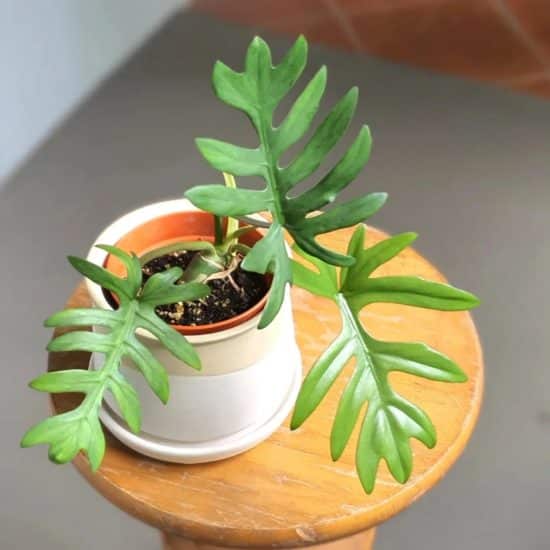
That’s a wrap for our Philodendron Mayoi care guide! With its unique growth pattern and eye-catching looks, this lovely houseplant will definitely brighten up your living space and impress your guests.
Philodendron mayoi care summary:
- Place your plant in bright, indirect light, and keep it away from harsh sunlight to prevent leaf burn.
- Water your plant when the top half of the soil has gone dry.
- Maintain a comfortable temperature range of 65-80°F (18-27°C) and aim for a humidity level of 40%-60%.
- Use a well-draining soil mix with added sand for optimal root development.
- Fertilize during the growing season.
We hope this guide has equipped you with the knowledge to care for your Philodendron Mayoi and enjoy its unique beauty.
If you found this article helpful, don’t hesitate to share it with fellow plant lovers! Should you have any questions, feel free to reach out to us.
Happy growing!
FAQ
Is Philodendron Mayoi rare?
Philodendron Mayoi is indeed a rare variety within the Philodendron family. Its unique appeal lies in its striking leaf shape and delicate veining. Keep in mind that rare plants may be harder to find in local nurseries, so be prepared to search online or reach out to specialty plant shops to add this gem to your collection.
Is Philodendron Mayoi a climber?
Yes! These plants naturally grow by attaching themselves to tree trunks or other sturdy structures, seeking sunlight by climbing upward. You can replicate this growing habit at home by providing a moss pole or coir totem for your Philodendron Mayoi to climb.
This not only supports the plant’s natural growth pattern, but also adds an attractive vertical element to your indoor garden. Be prepared to help your plant out by securing its stems around the support structure using ties or clips so it has a good foundation to continue its climb.
Is Philodendron Mayoi toxic?
Yes. Unfortunately, the Philodendron Mayoi is indeed toxic to both humans and pets. The plant contains calcium oxalate crystals which are toxic if ingested. To keep your household safe, place the plant in an area out of reach for children and pets.

